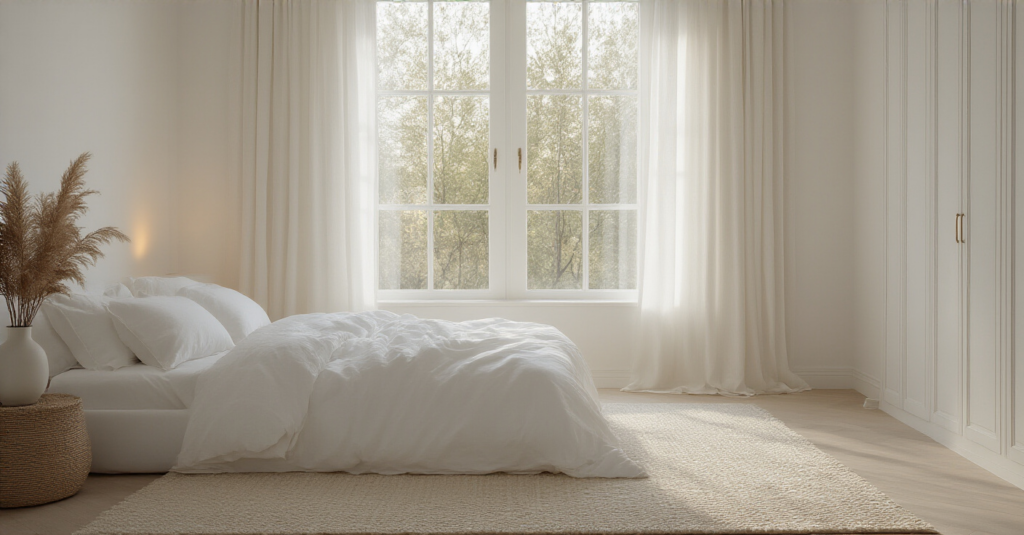You know what people always ask me? How to get that calm, restorative feeling of being in a perfectly designed garden, but inside their own bedroom. They’ve seen pictures of these stunning all-white rooms that look like a sanctuary, but they’re scared. Scared it will look like a hospital room. Cold. Sterile. Boring. And honestly, they’re right to be worried, because most people get it completely wrong.
The secret isn’t just about painting the walls white. That’s step one, and it’s the easiest one to mess up. A truly serene white room isn’t about the absence of color; it’s about the presence of light, texture, and nature. It’s about creating a space that breathes. As someone who spends his days designing outdoor spaces that feel like extensions of the home, I treat a bedroom the exact same way—as a private courtyard for the soul. Forget the corporate-speak and the stats. Let’s talk about what actually works.
The Conceptual Canvas: Planning Your White Aesthetic (Part 1)
Before you even think about picking up a paintbrush, we need to lay the groundwork. This is the landscape architecture phase of the project. It’s about understanding the site—the light, the existing features, the mood you want to create. Rushing this part is how you end up with a room that feels ‘off’ and you can’t figure out why.
1. Deciphering White Undertones for Harmonic Room Design
Can we talk about why everyone gets white paint wrong? They walk into the store, grab a can of “Pure White,” and then wonder why their bedroom suddenly feels like a sterile, blue-tinted laboratory. Here’s the deal: white is never just white. It’s always leaning somewhere—towards yellow (warm), towards blue (cool), or towards gray (neutral). Ignoring this is the fastest way to create a room that feels completely at odds with itself.
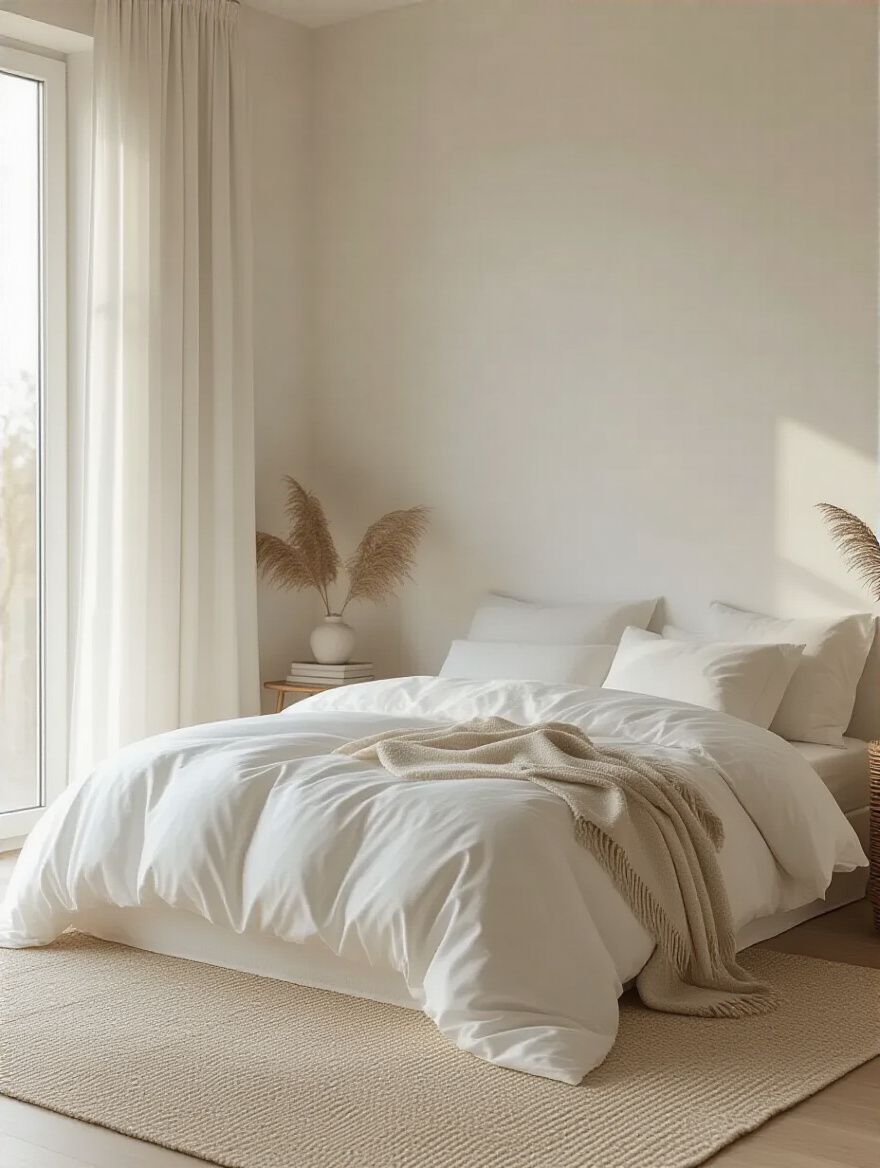
Think of it like choosing stone for a patio. You wouldn’t just grab any gray paver without seeing if its undertones clashed with the brick on your house, right? Same thing here. Look at your floors, your trim, any furniture you can’t get rid of. Do they have warm, yellowish, or reddish tones? Then you need a white with a creamy or warm undertone to match. Are your elements cool-toned? Go for a crisper, cooler white. Get this right, and the whole room will feel like it’s singing in harmony.
2. Harnessing Natural Light to Brighten and Expand Your Room
In my line of work, light isn’t just a utility; it’s a building material. And in a white bedroom, it’s your most powerful tool. The whole point of a white room is to capture and bounce light around, to create a sense of airy openness that feels connected to the world outside. The biggest mistake people make is blocking their windows with heavy, light-sucking drapes. It’s like planting a gorgeous garden and then building a wall in front of it.

So, get those windows working for you. Sheer linen curtains are your best friend—they diffuse harsh sunlight into a soft, ethereal glow that fills every corner of the room. And here’s the shortcut I wish I knew earlier: place a large, simple mirror directly opposite your main window. It literally acts as a second window, doubling the amount of light and creating an illusion of depth that can make a small room feel twice its size. You want your room to feel like a sun-drenched terrace, not a cave.
3. Defining Your Ideal White Bedroom Style: Modern to Bohemian
Saying you want a “white bedroom” is like telling me you want a “garden.” Okay, great. But do you want a wild, rambling English cottage garden, or a serene, minimalist Japanese rock garden? They are wildly different experiences. You have to get specific. Before you buy a single thing, you need to decide what story you’re trying to tell. Are you aiming for crisp, modern lines? A cozy, layered farmhouse feel? Or a relaxed, textured bohemian vibe?
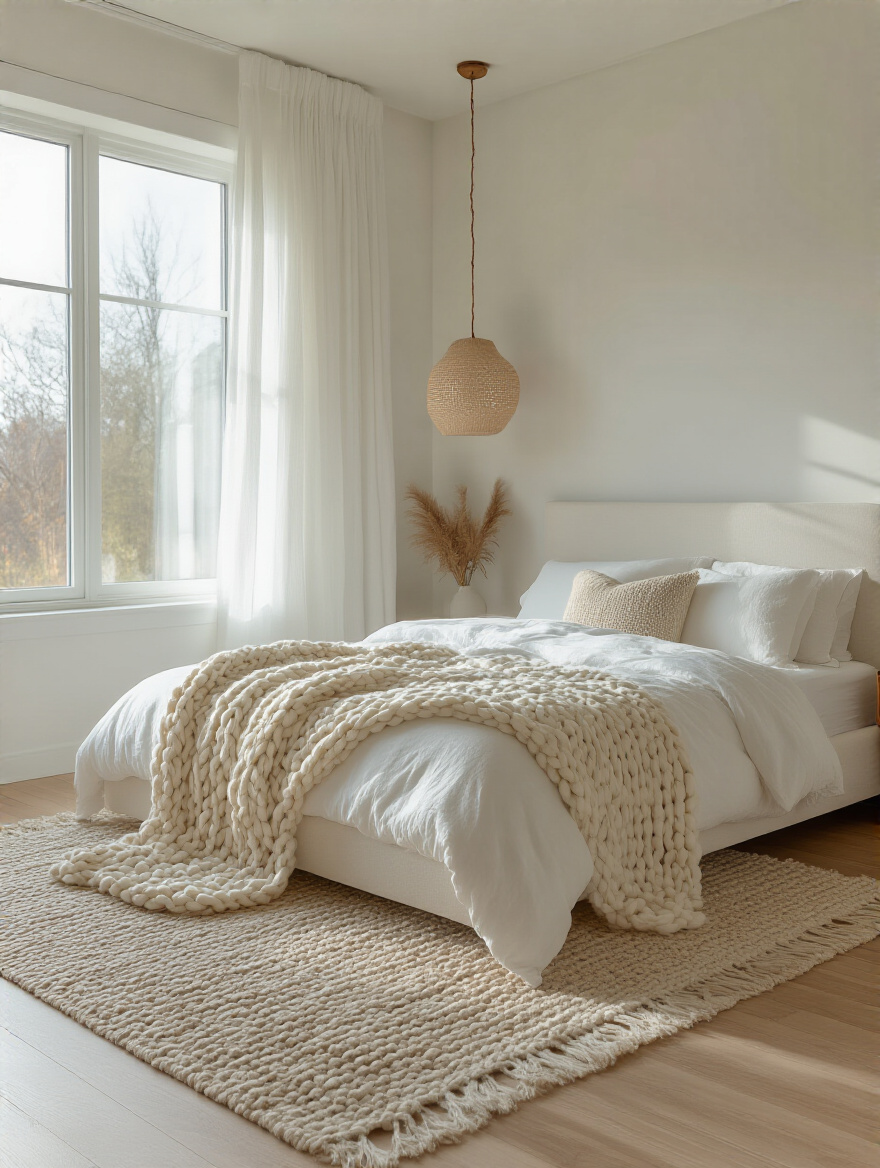
Go on Pinterest and start a board, but be ruthless. Look for the common threads. Are you consistently drawn to clean lines and uncluttered surfaces? That’s modern. Do you love chunky knits, plants, and handmade pieces? That’s bohemian. Defining this north star is what stops you from buying a bunch of stuff you like individually but that looks like a chaotic mess when you put it all together. This clarity is what makes a room feel intentional and peaceful, rather than random and cluttered.
4. Strategic Furniture Layout for Optimal Flow and Serenity
A room with bad flow is just as stressful as a crowded party where you can’t move. In a space dedicated to rest, flow is everything. Before you shove a bed against a wall and call it a day, think like a landscape architect. We design pathways that guide people through a garden effortlessly. You need to do the same thing in your bedroom. There should be clear, easy paths from the door to the bed, to the closet, to the windows.
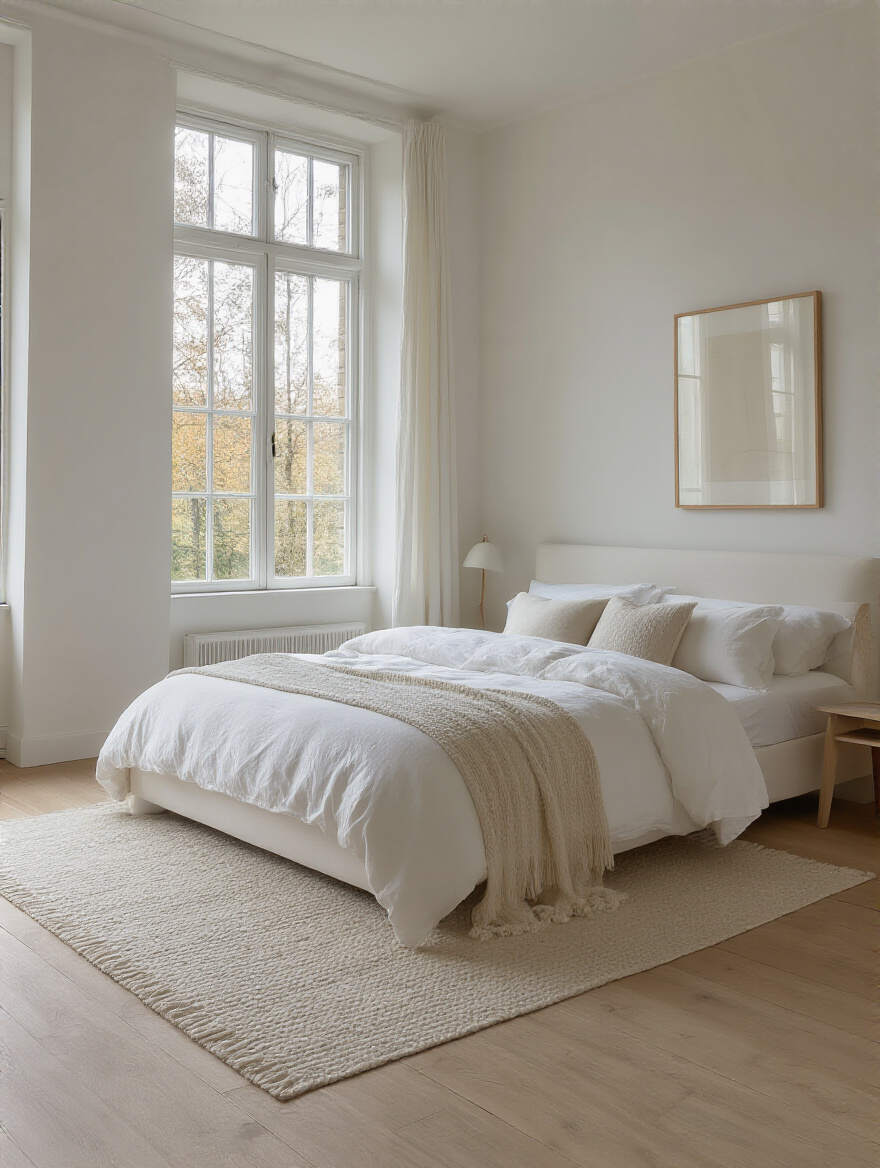
The key is negative space. Give your furniture room to breathe. Don’t cram every square inch with stuff. A good rule of thumb is to have about three feet of clearance for your main walkways. I once worked with a client who had a massive, beautiful bedroom but felt anxious in it. We simply rearranged the furniture to create a clear, open path from the door to a seating area by the window, and it completely changed the energy of the room. Your body registers a cluttered path as an obstacle course, and that is the opposite of serene.
This early planning phase is where the real magic happens. By getting these core concepts right—the specific white, the light, the style, and the flow—you create a foundation that everything else can build on. It’s the difference between a beautiful space and a space that just feels right.
The Conceptual Canvas: Planning Your White Aesthetic (Part 2)
Once you have the big ideas mapped out, it’s time to bring them into focus. Think of this next step as creating a detailed planting plan for your garden. You wouldn’t just start digging holes randomly; you’d figure out exactly what goes where to create a cohesive, beautiful whole.
5. Creating a Mood Board for Visualizing Your Pristine Vision
Forget what you think a mood board is. It’s not some corporate presentation tool. A real, useful mood board is a physical, tactile collection of the feeling you want to create. It’s your gut check. It’s the one thing that will save you from making expensive mistakes. I learned this the hard way years ago on a project where the client said they wanted “natural,” but their idea of natural and my idea were miles apart. We wasted a ton of time until I had them physically gather samples.
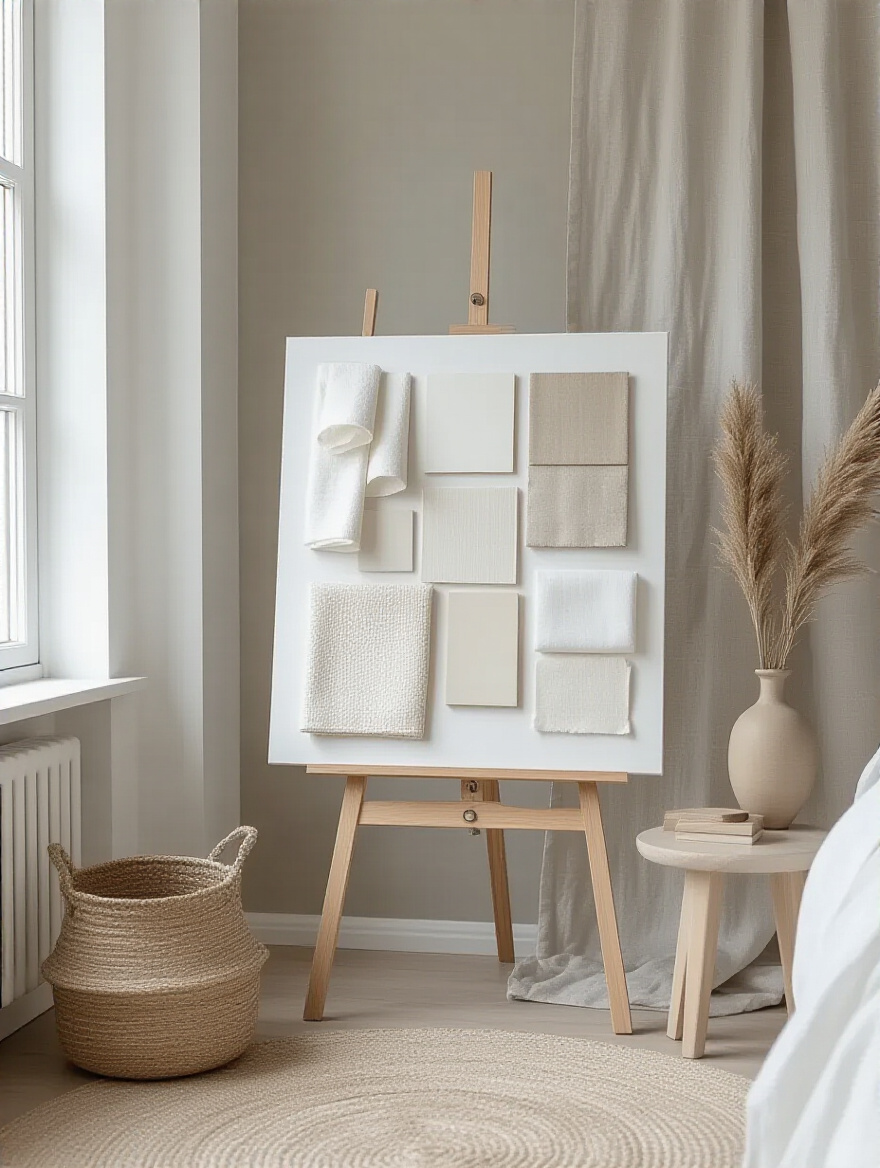
So, do this for your bedroom. Get a piece of foam board. Tack up a few of your favorite inspiration images. But then—and this is the important part—add real things. A swatch of the linen you love for the bedding. A paint chip of the actual white you’re considering. A small piece of wood in the tone you want for the floor or furniture. A pebble from the beach that has the perfect pale grey color. When you put all these things together, you’ll know instantly if they work. You can see and feel the harmony, and it’s a much more honest guide than any picture on a screen.
Core Elements: Building Blocks of White Serenity (Part 1)
With your plan in hand, it’s time to bring in the foundational pieces. These are the big, structural elements that will define the space. They are the ‘hardscaping’ of your bedroom—the patios, pathways, and pergolas that give the room its shape and character long before you add the softer touches.
6. Selecting Statement White Furniture for Elegant Anchors
Your big furniture pieces—the bed, the dresser, an armchair—are the anchors of the room. They provide the structure. In a white bedroom, choosing these in a shade of white can create an incredibly sophisticated, seamless look, making the room feel larger and more cohesive. The key is to avoid buying a matching “set,” which can look dated and flat. Instead, think about form and texture.

A bed with a soft, upholstered white headboard adds a layer of comfort, while a high-gloss lacquer dresser can bring a touch of modern sleekness. These pieces shouldn’t scream for attention; they should feel like they’ve grown out of the room itself. The goal is to ground the space without adding visual weight. Think of them as the beautifully pruned specimen trees in a garden—they create a focal point and structure without overwhelming the view.
7. Choosing Varied Wall Finishes Beyond Standard Flat White
If you do only one thing from this list, do this. Please, do not just slap a coat of builder-grade flat white paint on your walls. That’s the primary culprit behind the “sterile hospital” vibe. Texture is what gives a white room depth, soul, and a sense of life. A textured wall finish catches the light in a thousand different ways throughout the day, making the room feel dynamic and alive.
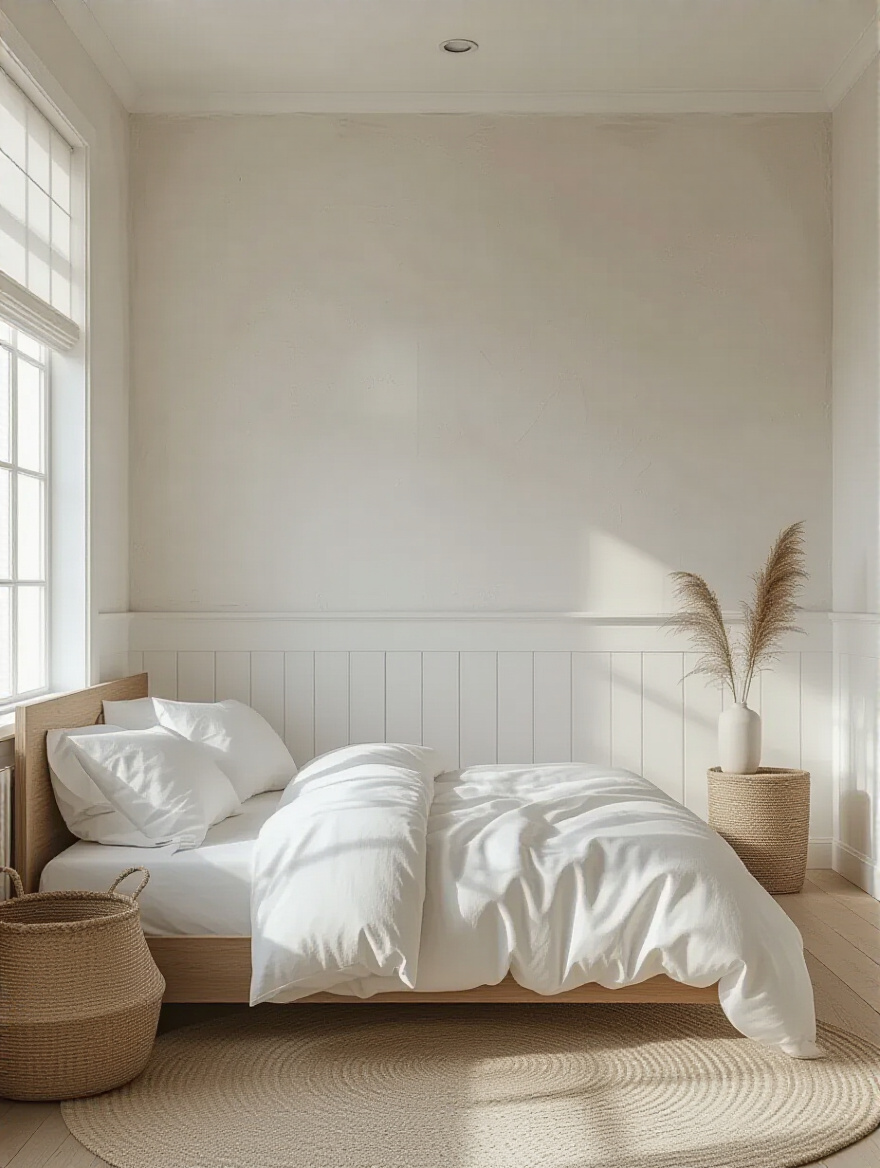
Look into finishes like limewash or Roman clay. They have a soft, chalky, organic quality that feels ancient and calming, like the walls of a Mediterranean villa. Even something as simple as applying shiplap or a subtle grasscloth wallpaper in a shade of white can add incredible architectural interest. It transforms the wall from a blank surface into a tactile experience. It’s the difference between a patch of dirt and a richly planted garden bed—one is just a surface, the other is full of life.
8. Layering Textural White Bedding for Ultimate Comfort
The bed is the heart of the bedroom, and this is where you can go wild with texture. Layering different white fabrics is what will make your bed look like a luxurious cloud you can’t wait to sink into. A flat, single-material bed looks sad and uninviting. The secret is to mix and match weaves and materials. Start with crisp cotton percale sheets, add a crinkled linen duvet, throw on a waffle-weave blanket, and top it all off with a chunky knit throw pillow.
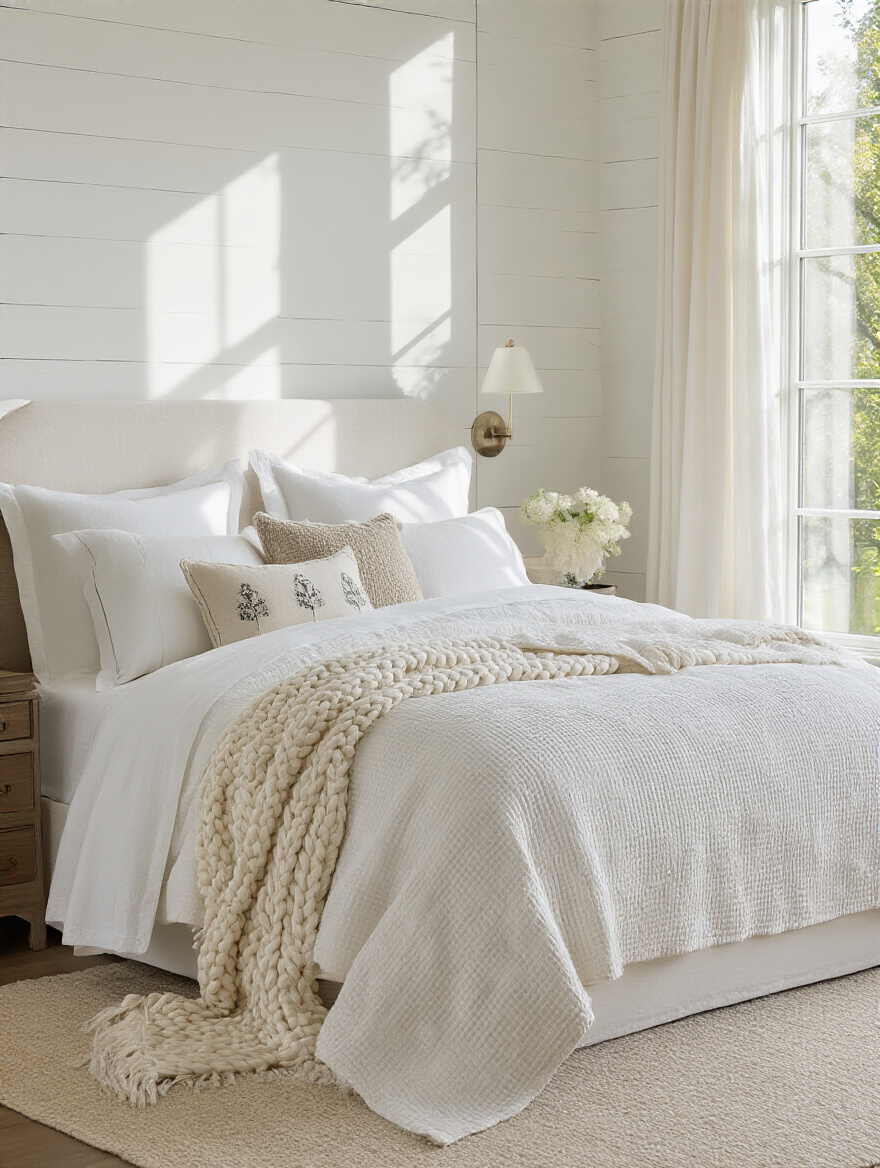
Each layer should be a slightly different shade of white—from bright optic white to creamy ivory to a soft off-white. This subtle variation is what gives the bed incredible visual depth. It tricks the eye into seeing more than just “white.” It’s about creating a rich, sensory experience. You want your bed to not only look comfortable but to feel incredible, inviting you to touch and experience all those different textures.
9. Integrating Wood, Rattan, or Metallic Accents Thoughtfully
Okay, now for the secret weapon to keep your white room from feeling cold: natural elements. You absolutely need to introduce wood, rattan, woven seagrass, or even some subtle metallic touches to ground the space. These elements bring the warmth and texture of the natural world inside, providing a crucial counterbalance to all the white. Without them, a white room can feel floaty and sterile; with them, it feels grounded and human.
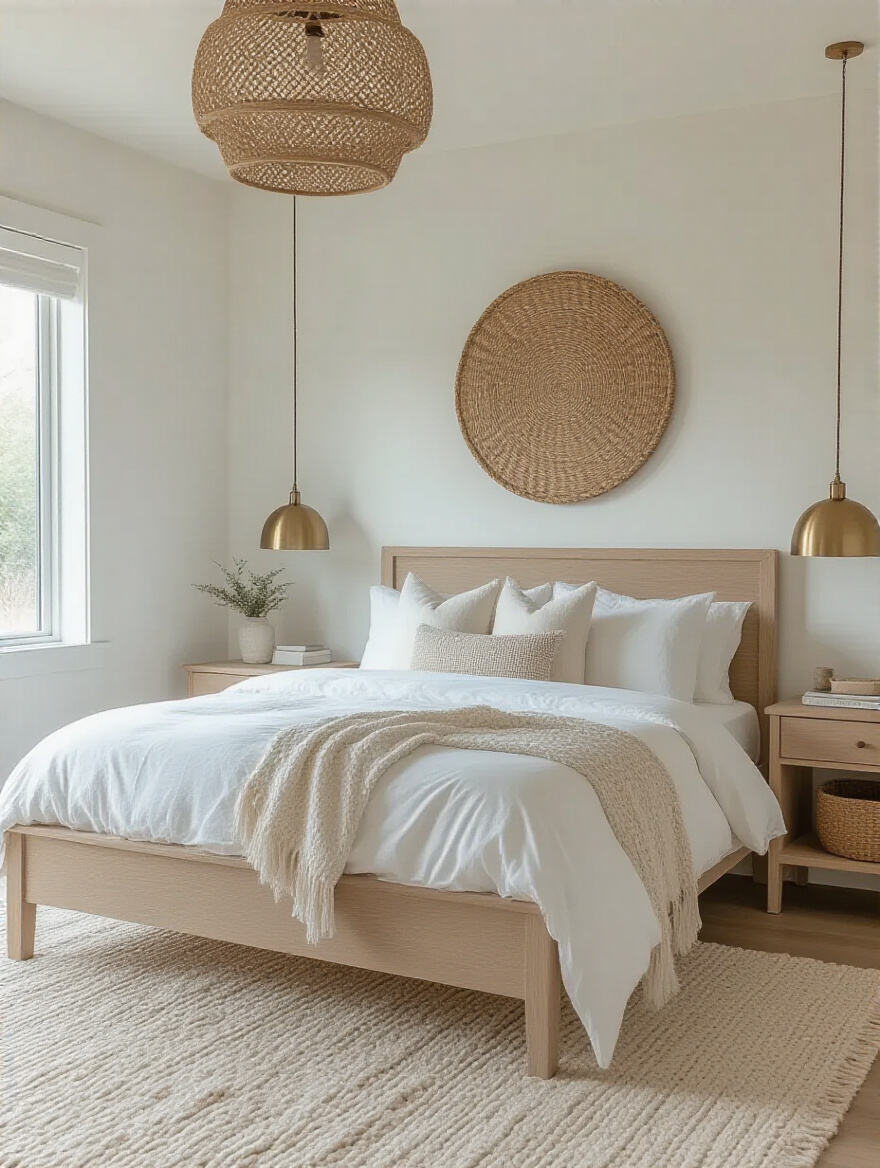
I once had a client who was terrified of adding wood tones to their all-white scheme. The room just wasn’t working. It felt cold and unwelcoming. Finally, I convinced them to just try a simple, light-oak bench at the foot of the bed. It instantly warmed up the entire room. The wood gave the eye a place to rest and made all the whites around it look richer and more intentional. Don’t be afraid of this step. It’s what connects your indoor sanctuary back to the earth.
With these core pieces in place, your room will already have a strong, serene personality. You’ve built the bones, and now you’re ready to bring in the finer details that will truly make it sing.
Core Elements: Building Blocks of White Serenity (Part 2)
We’re not done with the essentials just yet. One of the most important building blocks of a serene space has nothing to do with aesthetics and everything to do with function. After all, you can’t feel calm in a room that’s secretly a mess.
10. Smartly Incorporating White or Hidden Storage Solutions
Clutter is the absolute enemy of a tranquil space. Full stop. All the beautiful textures and natural light in the world won’t save a room that’s covered in clothes, books, and random junk. Your storage solutions in a white bedroom should be designed to disappear. The goal is to eliminate visual noise so your mind has a chance to actually quiet down.
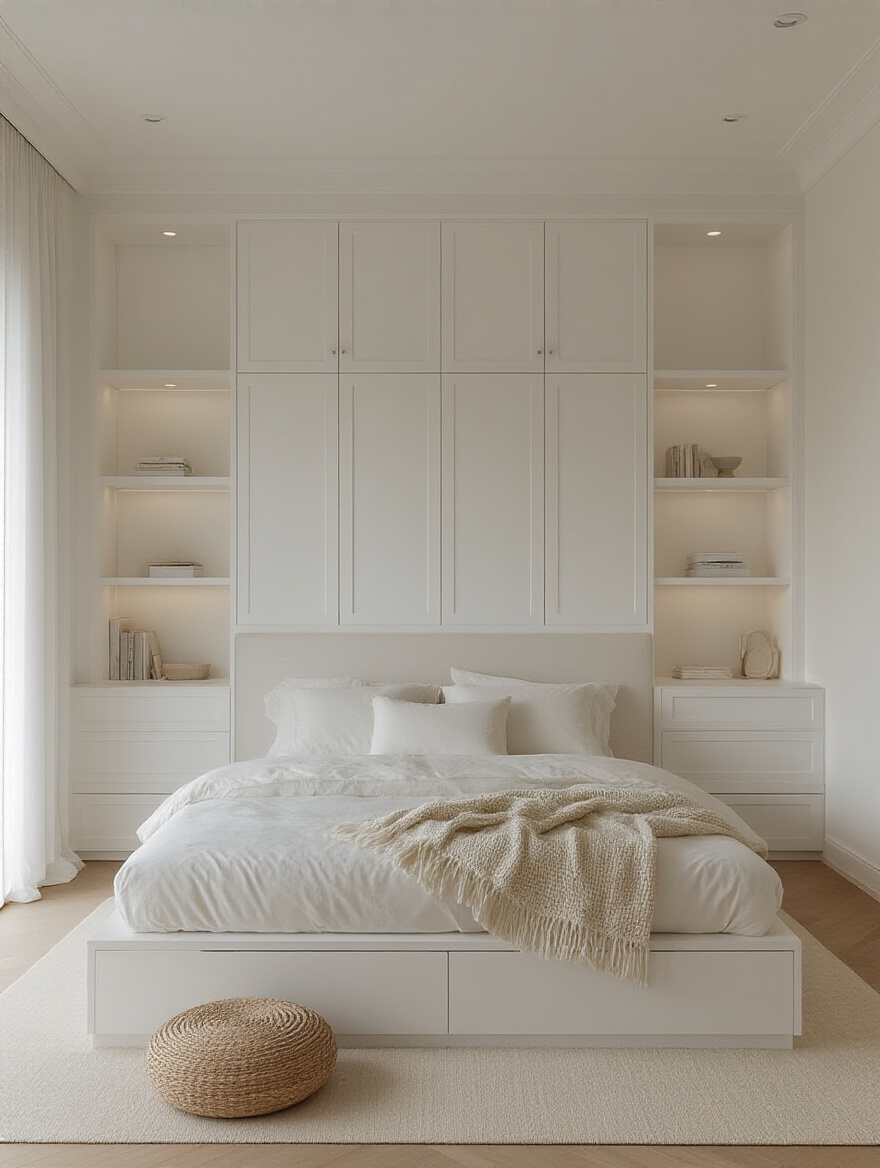
Opt for furniture that does double duty, like a bed with built-in drawers underneath or a beautiful storage ottoman at the foot of the bed. If you need a wardrobe or dresser, choose white pieces with flat-fronted, handleless doors that blend right into the wall. Think of it as creating a seamless, quiet backdrop for your life. The less your storage screams “I’m a box for all your stuff!” the more peaceful the room will feel.
Elevating the Details: Styling Your White Retreat (Part 1)
Now that the foundation is solid and the clutter is gone, it’s time for the fun part. These are the finishing touches—the ‘plantings’ and ‘decor’ of your room—that will bring it to life and infuse it with personality. This is where you elevate your space from simply being a ‘white room’ to being your sanctuary.
11. Introducing Subtle Contrast with Pale Neutrals and Pastels
A pure, all-white room can be stunning, but for some, it can feel a little too stark. If that’s you, the answer isn’t to add a loud pop of color, which would shatter the peace. The answer is to whisper in some subtle contrast with very pale neutrals and soft, desaturated pastels. Think about the colors of a cloudy dawn: soft grey, pale blush, a hint of sage green, or a dusty sky blue.
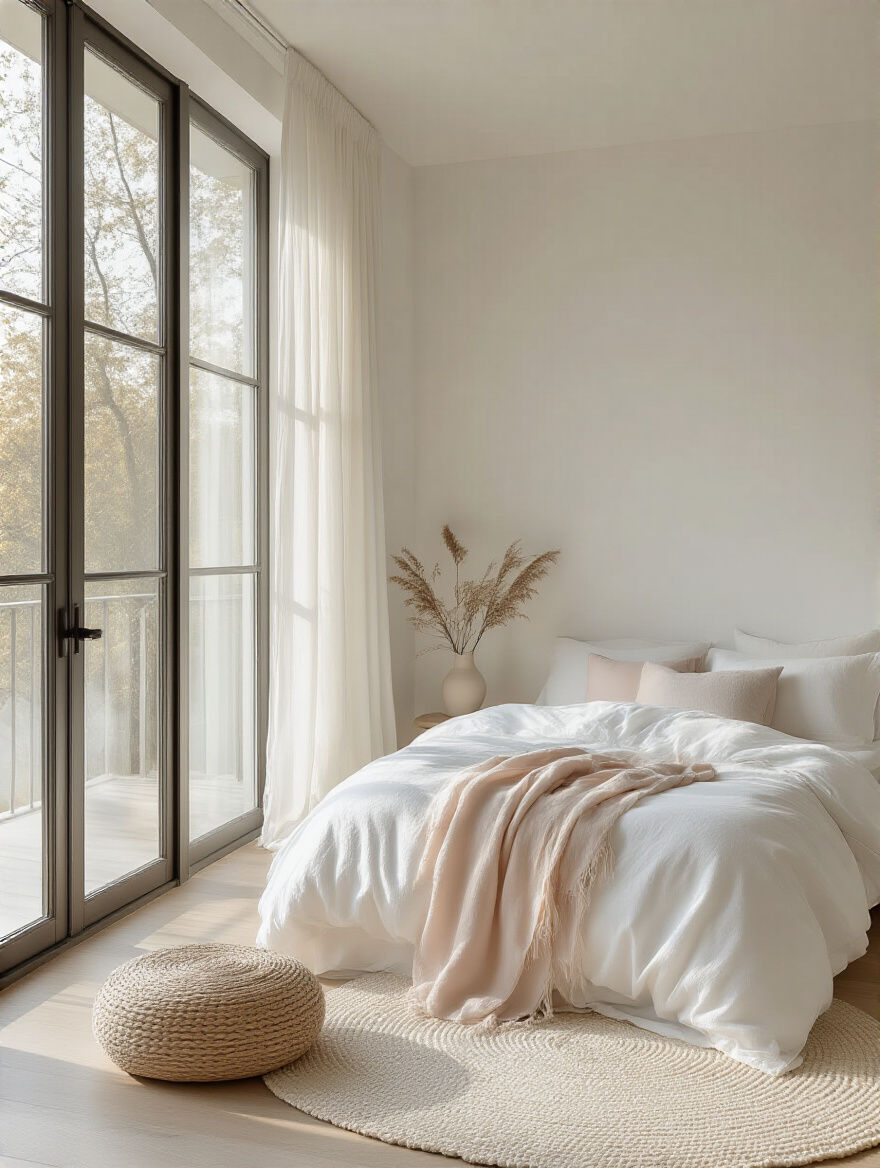
Bring these quiet colors in through your accessories: a couple of throw pillows, a light cashmere throw at the foot of the bed, or a piece of art. The key is to keep them muted and use them sparingly. They shouldn’t compete with the white; they should complement it, adding just enough depth and warmth to take the edge off. It’s like adding a few silver-leafed plants to a garden—it makes all the other greens around them look richer.
12. Strategically Placing Mirrors to Maximize Light and Space
We talked about using mirrors to bounce light, but they can do so much more. Think of a mirror as a piece of art that reflects and frames a view. The number one rule is to be intentional about what it reflects. Don’t just hang one on a random wall where it will reflect a blank hallway or a cluttered corner. You’re just amplifying what you don’t want to see.
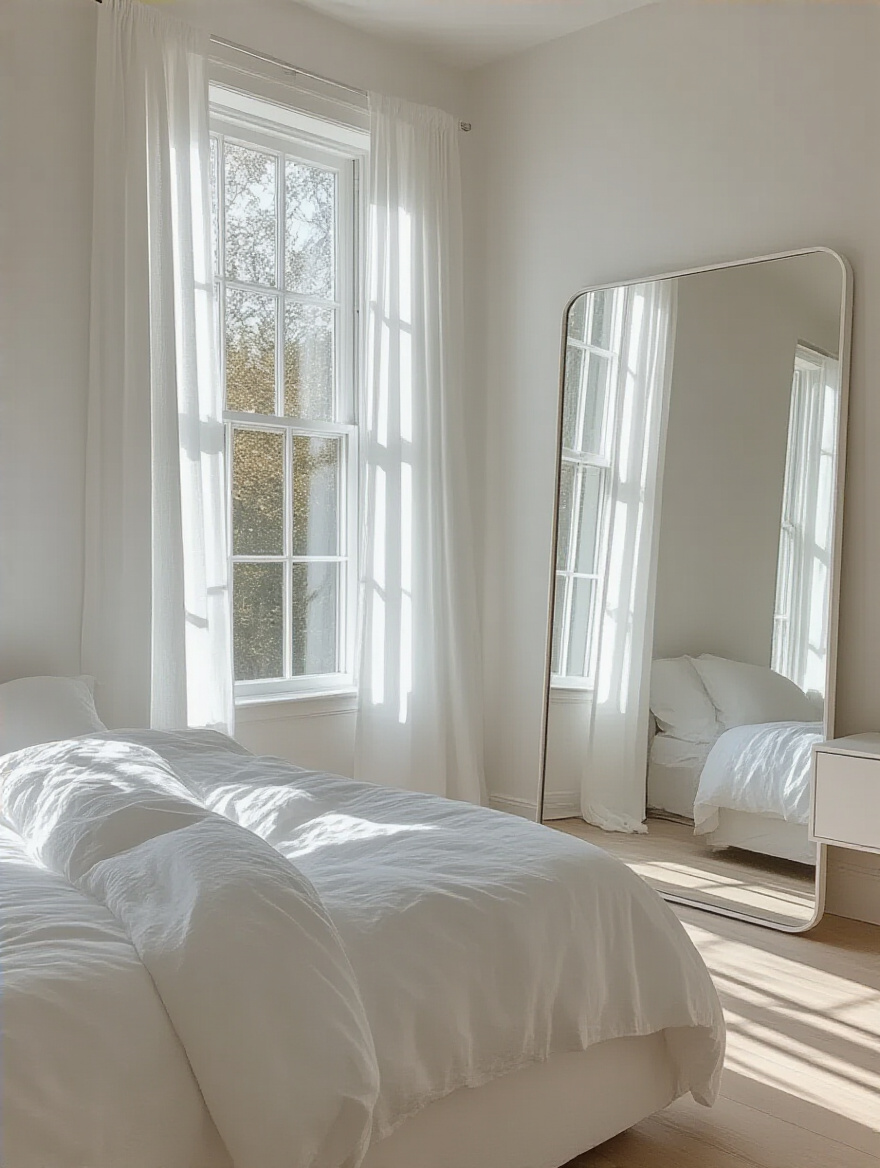
Instead, use mirrors to create a beautiful illusion. A long floor mirror leaning against a wall can create a sense of a doorway to another room. A collection of small, vintage-style mirrors can act like a gallery wall that shimmers and catches the light. Used thoughtfully, they add a touch of magic and glamour, making your serene space feel just a little more expansive and special.
13. Bringing Life with Indoor Plants for a Touch of Green
Every single room I design, indoors or out, has plants. A white bedroom, especially, needs the life and organic form that only a plant can provide. It’s a non-negotiable. They are the easiest and most effective way to breathe life and a touch of vibrant, natural color into your serene space. The deep green leaves against a crisp white wall is a classic combination for a reason—it’s pure, natural beauty.
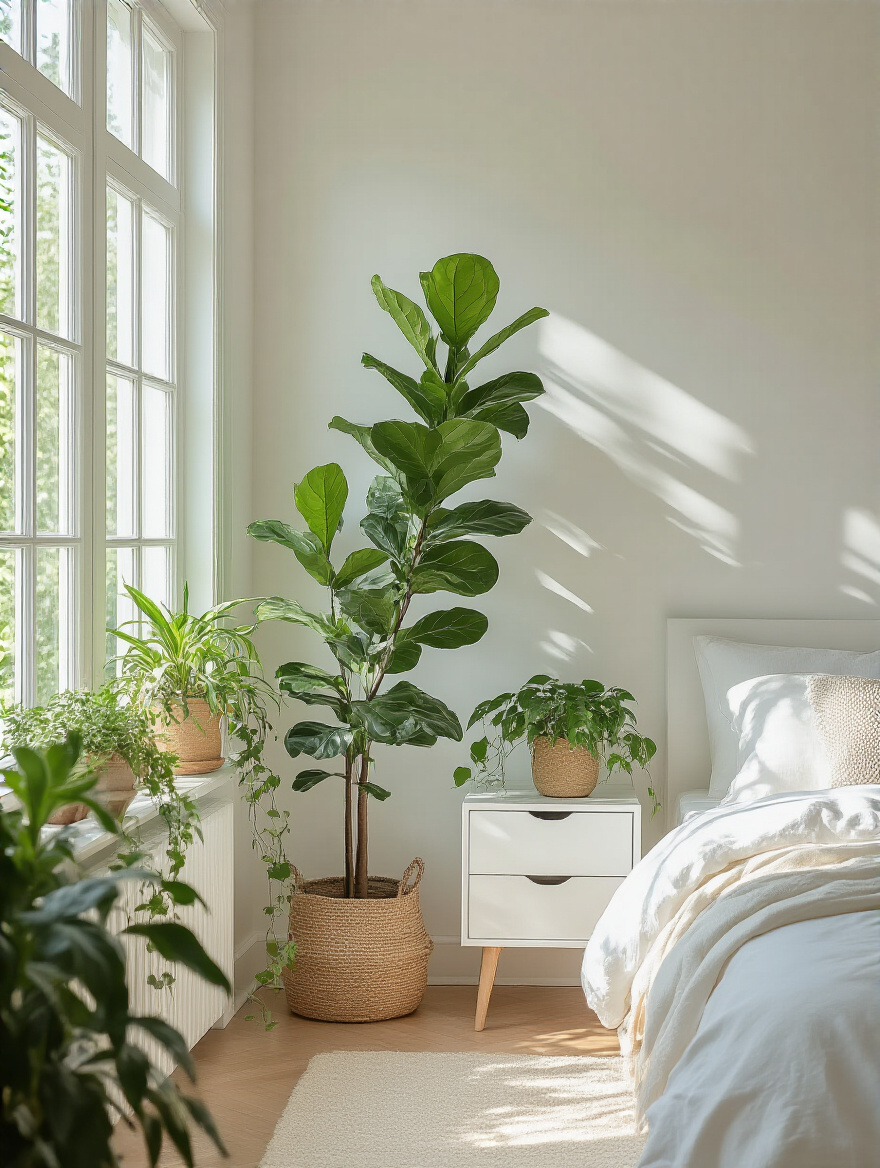
Don’t just get one tiny succulent and call it a day. Think in terms of scale and form. A tall Fiddle Leaf Fig in a corner can act as a living sculpture, its height drawing the eye upward. A trailing Pothos on a high shelf introduces a sense of soft movement. Choose plants with interesting leaf shapes and textures. They’re your connection to the outdoors, purifying the air and reminding you of the quiet, steady rhythm of nature.
14. Designing Layered Lighting Schemes for Ambience and Task
Never, ever rely on a single, harsh overhead light. It’s the fastest way to ruin the atmosphere of any room, especially one designed for serenity. Just like in a garden, you need layers of light for different purposes and moods. You need three types: ambient, task, and accent.
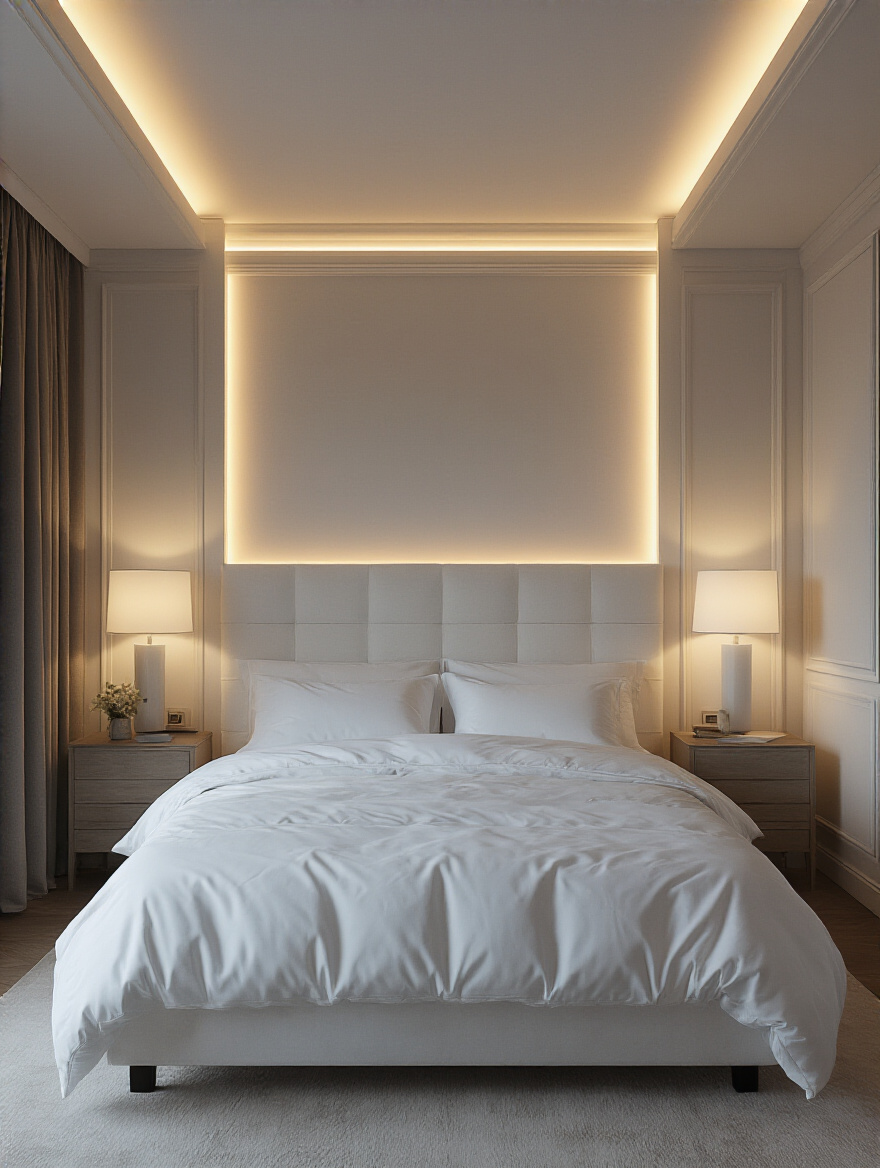
Ambient light is your general, overall glow—this can come from a beautiful, diffused ceiling fixture or hidden cove lighting. Task lighting is for specific activities, like a sleek reading lamp by the bed or a light over a vanity. Accent lighting is the sparkle—a small uplight behind a plant or a picture light over a piece of art. And the most important part? Put everything on a dimmer. Being able to soften the lights down to a warm, gentle glow in the evening is the final ingredient for creating a truly tranquil retreat.
The details are what will make your space feel unique and cared for. These small, thoughtful additions transform a room from a concept into a home.
Elevating the Details: Styling Your White Retreat (Part 2)
This final layer of detail is what makes the space unequivocally yours. It’s about moving beyond general design principles and curating objects that hold personal meaning. This is how you give your serene sanctuary a soul.
15. Curating Meaningful Artwork and Decorative Objects
Your room shouldn’t look like a page from a catalog. It should tell your story. Now that you have this beautiful, serene white canvas, anything you place on it will have an enormous impact. So, be incredibly intentional. Choose one or two pieces of art that you truly love, that make you feel something. It could be a large, calming abstract painting or a collection of small black-and-white photos from a favorite trip.
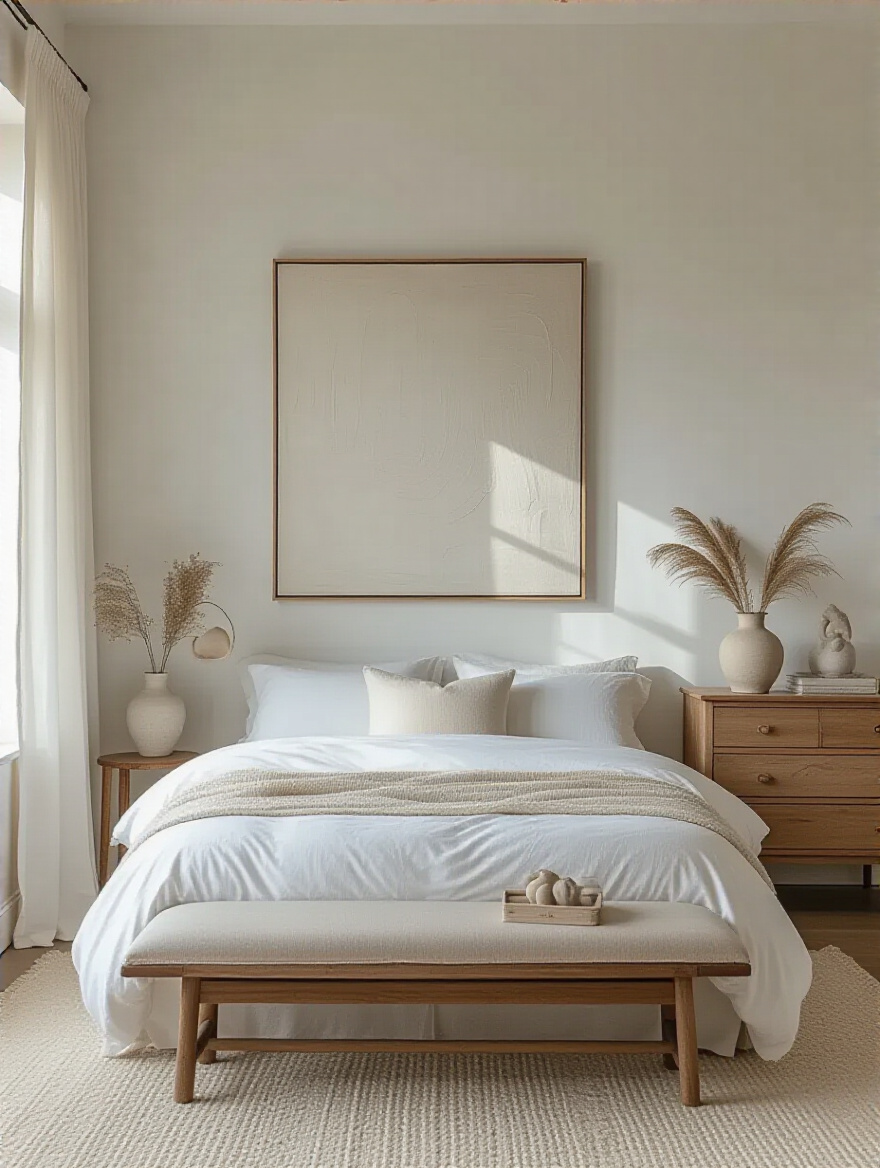
The same goes for decorative objects. Don’t just buy “stuff” to fill a shelf. Display things that mean something. A beautiful ceramic bowl you picked up from a local artist, a stack of your favorite books, a smooth stone from a memorable hike. Each object should earn its place. A white backdrop gives these personal items the space to shine, turning your room into a gallery of your own life and creating a space that feels deeply and authentically you.
Refinement & Longevity: Maintaining Your Pristine Space (Part 1)
Alright, you’ve designed your dream sanctuary. It’s perfect. Now, how do you keep it that way? A lot of people are scared off by white because they think it’s impossible to maintain. But that’s just not true if you’re smart about it from the beginning. It’s like planting a low-maintenance garden—a little bit of foresight saves you a ton of work down the road.
16. Choosing Durable and Easy-to-Clean White Fabrics
This is all about material science. Don’t just buy the cheapest white sheets you can find. Look for high-quality fabrics that are built to last and, more importantly, easy to clean. Long-staple cottons like Percale are fantastic because they’re durable, breathable, and get softer with every wash. Linen is another great choice; it’s naturally stain-resistant and its characteristic crinkle hides any minor imperfections.
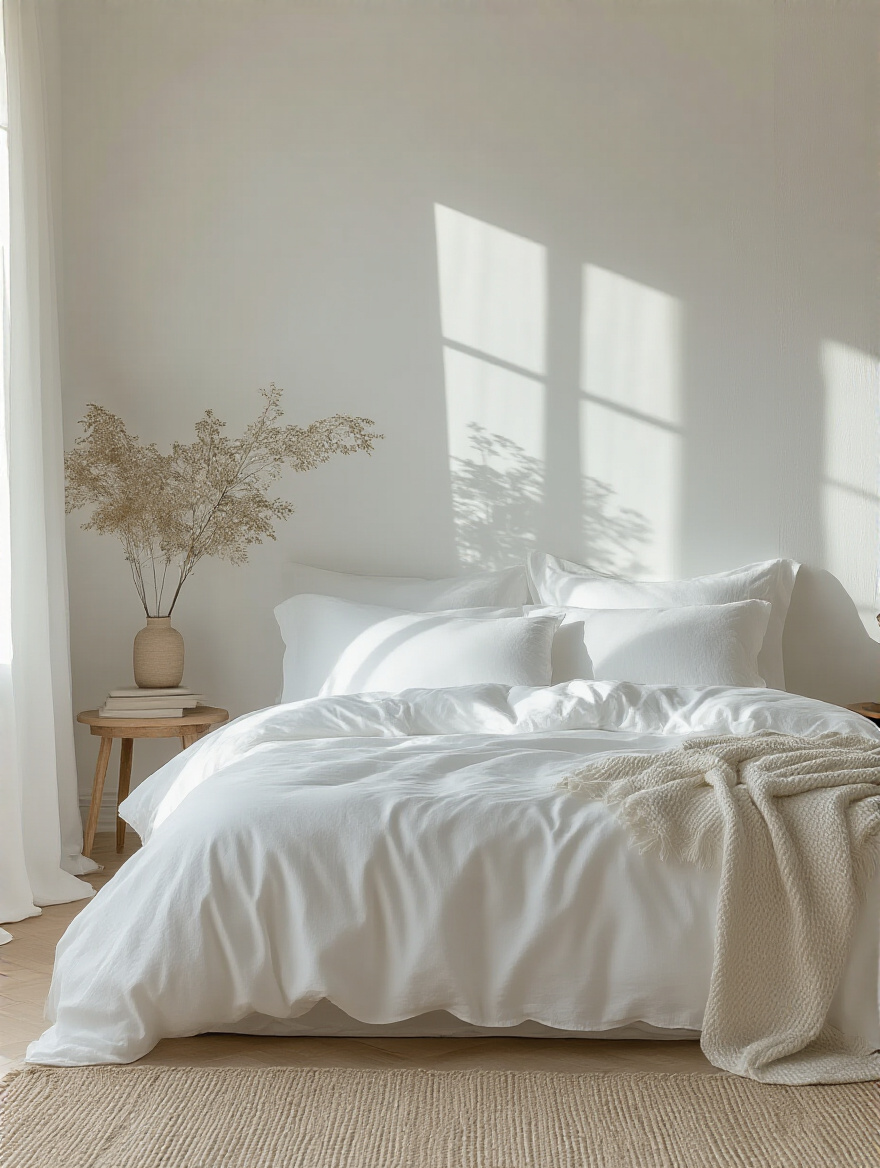
And here’s a tip I’ve borrowed from my outdoor furniture world: look into performance fabrics for things like upholstered headboards or armchairs. There are now amazing indoor fabrics that are stain-resistant and can be cleaned with just soap and water. Investing in the right materials upfront is the key to a white room that looks pristine without you having to stress over every little spill. It’s practical, not precious.
17. Implementing a Simple, Effective Cleaning Routine
You don’t need to spend every Saturday deep-cleaning. The key to maintaining a white room is consistent, low-effort maintenance. Think of it as light gardening. You wouldn’t let your garden get completely overrun with weeds before tackling it; you pull a few here and there every time you walk by. Do the same in your bedroom.
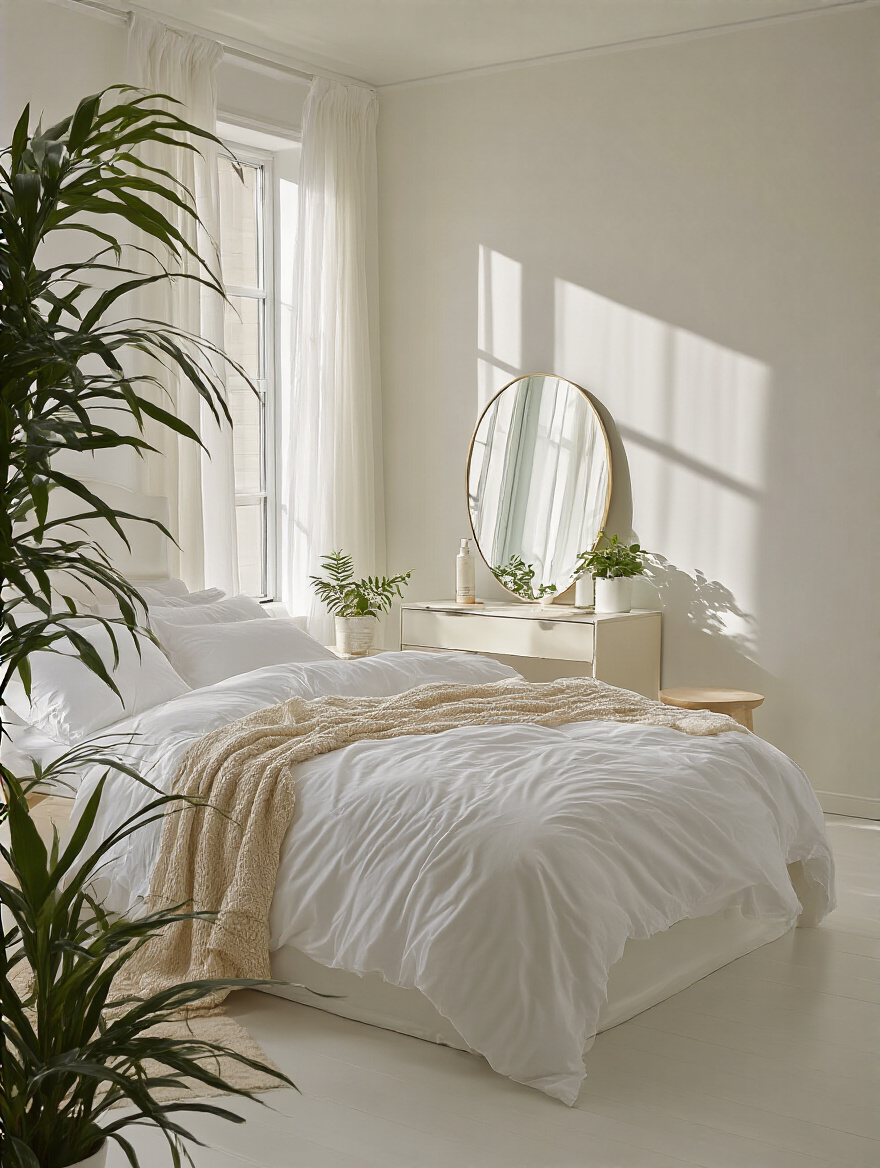
Keep a microfiber cloth handy to quickly wipe down surfaces every other day to prevent dust from building up. Vacuum regularly. And, most importantly, launder your white bedding once a week with an oxygen-based brightener (not chlorine bleach, which can cause yellowing over time) to keep it brilliantly white. A simple, consistent routine is far less daunting and far more effective than massive, infrequent cleaning sprees.
18. Refreshing Your Space with Seasonal Decor Swaps
One of the best things about a neutral, white backdrop is that it’s incredibly easy to update with the seasons. This keeps the space from feeling static and boring, and it connects your indoor sanctuary to the rhythm of the year outside. It’s a simple trick that has a huge psychological impact, making your space feel fresh and alive.
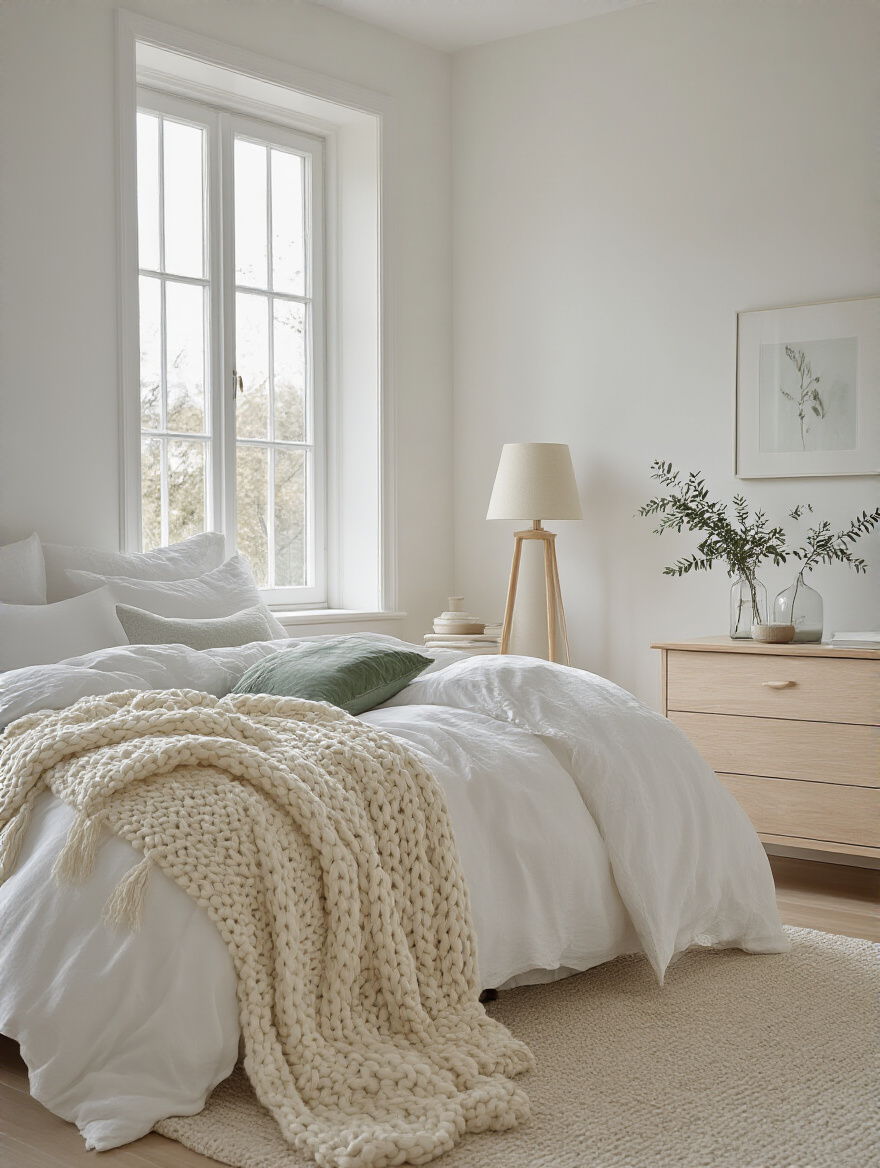
It doesn’t have to be a major overhaul. In the fall and winter, swap your light linen throw for a chunky wool or cashmere one in a creamy off-white. Add a couple of velvet pillows. In the spring and summer, bring in a vase of fresh flowers from the garden and switch to lightweight cotton or linen textiles. This small act of seasonal rotation keeps the room feeling dynamic and new, and it gives you a chance to fall in love with your peaceful space all over again.
19. Considering Integrated Smart Home Features for Convenience
Technology should make your life easier and your space more serene, not more complicated. The best tech is invisible. In a white bedroom, smart home features can be amazing for reducing physical and visual clutter while adding a layer of effortless comfort.

Imagine waking up not to a blaring alarm, but to smart blinds slowly opening to let in the morning light, while your bedside lamp gradually brightens to a soft glow. Or, saying “Good night” and having all the lights dim, the temperature adjust, and a calming playlist begin to play softly. This kind of automation removes the small, jagged moments from your daily routines, creating a seamless experience that supports your goal of tranquility. Focus on features that enhance peace, not add distraction.
Keeping your serene space looking and feeling its best is an ongoing act of care. But by building good habits and using the right tools, it becomes a simple, rewarding ritual rather than a chore.
Refinement & Longevity: Maintaining Your Pristine Space (Part 2)
We’re in the home stretch. This is all about playing the long game—protecting your investment of time and energy to ensure your tranquil retreat stays that way for years. Think of it as protecting a mature garden from pests and disease. A little bit of prevention goes a long way.
20. Avoiding Common Mistakes That Dull Your White Aesthetic
I’ve seen so many beautiful white rooms lose their luster over time because of a few simple, avoidable mistakes. The biggest culprit is using the wrong light bulbs. If you put warm, yellowish-toned bulbs in a room with cool-toned white paint, the entire space is going to look dingy and sad, no matter how clean it is. Always match the temperature of your light bulbs (look for “daylight” or “cool white” on the packaging) to the undertone of your paint.
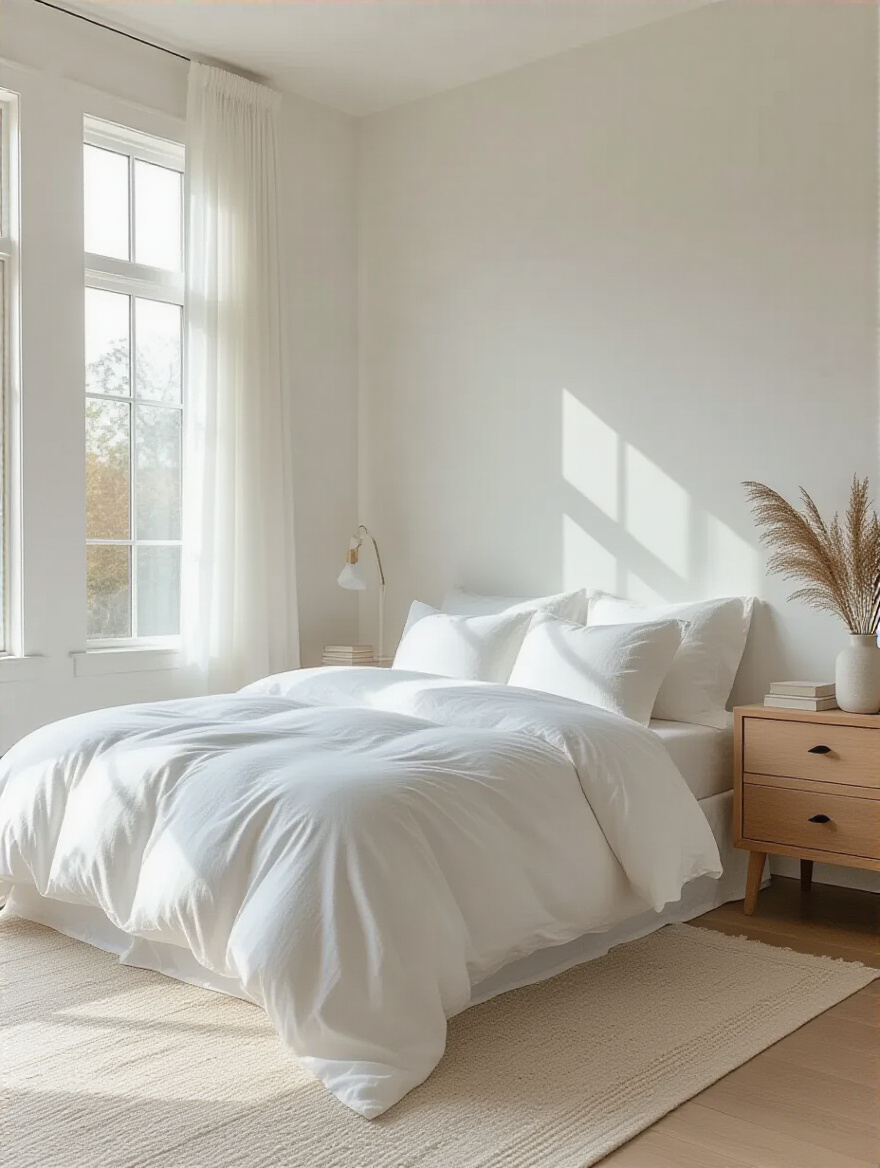
Another mistake is forgetting about the slow accumulation of grime. Airborne particles from cooking, candles, or even just open windows can create a subtle film on your white walls and furniture over time. Wiping down your walls with a damp cloth once or twice a year can make a shocking difference. And finally, stop using harsh cleaners and chlorine bleach! They break down fabrics and paint surfaces over time. Gentle, targeted cleaning is always the better path to long-term brilliance.
Conclusion
So, there you have it. Creating a white bedroom that feels like a true sanctuary is not about following a rigid, sterile formula. It’s an organic process. It’s about understanding that a room, like a garden, needs light to thrive, texture to feel alive, and natural elements to feel grounded. It needs room to breathe. When you stop thinking about white as a lack of color and start seeing it as a canvas for light, you unlock its incredible power to create a space that is profoundly peaceful and restorative.
Don’t be afraid of it. Start small. Bring in a few layers of white bedding. Add a beautiful Fiddle Leaf Fig to a sunlit corner. Paint one wall with a textured limewash and see how the light plays on it throughout the day. You’re not just decorating a room; you’re cultivating a feeling. You’re carving out a small piece of the world that is intentionally calm, deeply personal, and designed to recharge your soul. That is a space worth creating.
